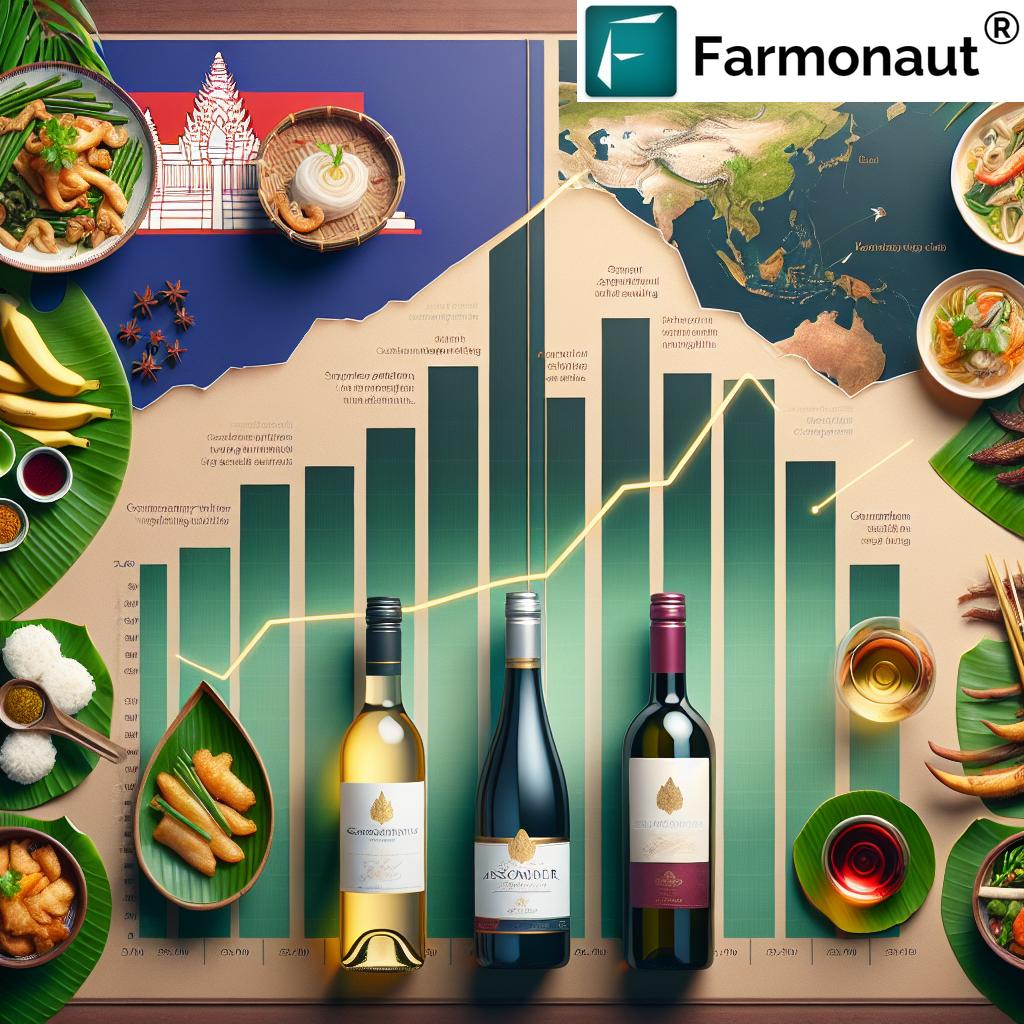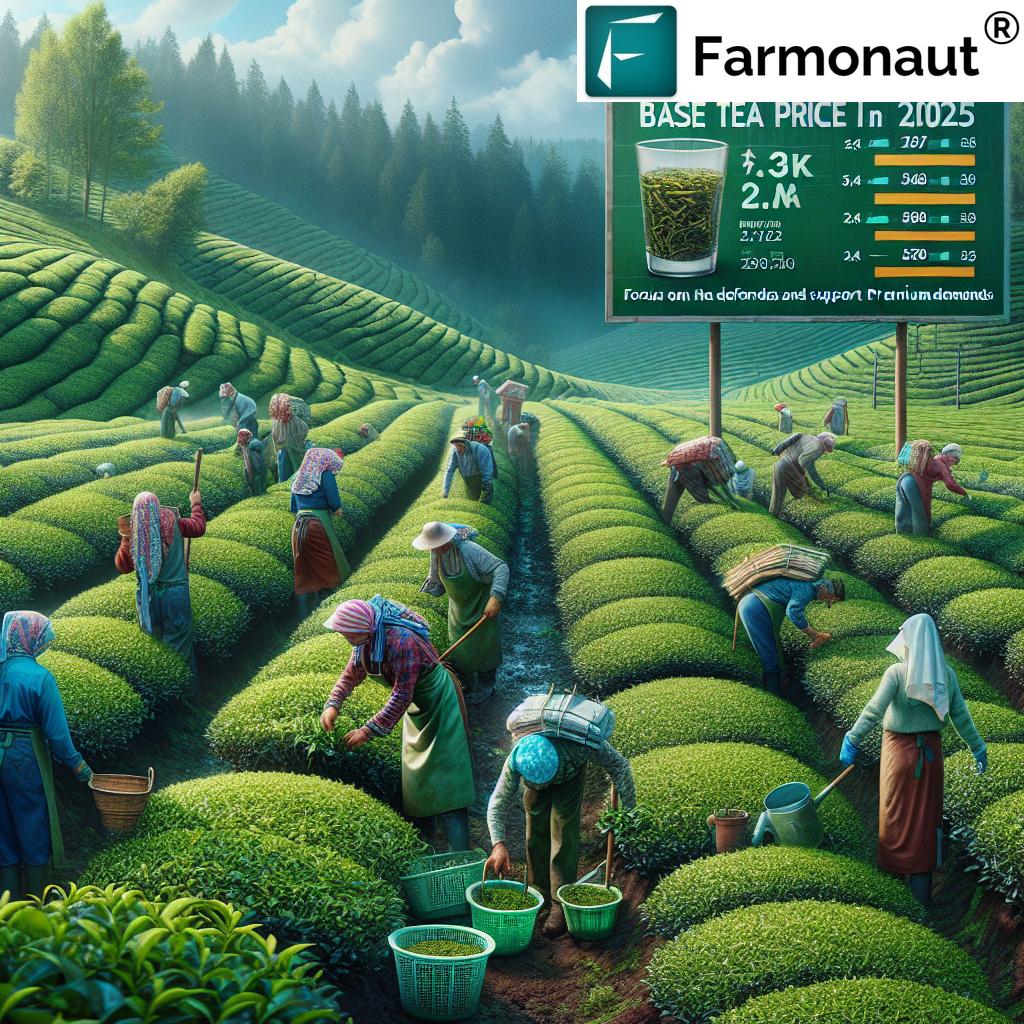Navigating Cambodia’s Wine Market: A Comprehensive Guide for Australian Exporters
“Cambodia’s tourism sector growth has led to a 15% annual increase in wine consumption since 2018.”
Welcome to our comprehensive guide on navigating Cambodia’s wine market for Australian exporters. As the Southeast Asian wine industry continues to evolve, we at Farmonaut recognize the growing opportunities for Australian wine exports to Cambodia. In this blog post, we’ll explore the intricacies of the Cambodian wine market, providing vital insights into ASEAN trade agreements, food safety regulations, and wine labeling requirements. Our goal is to equip Australian wine exporters with the knowledge and tools necessary to successfully enter and thrive in this emerging market.
Understanding the Cambodian Wine Market Landscape
The Cambodian wine market presents a unique opportunity for Australian exporters. With its rapidly growing tourism sector and expanding middle class, Cambodia is experiencing an increased demand for quality wines. Let’s delve into the key aspects of this market:
- Market Growth: The wine industry in Cambodia has shown consistent growth over the past few years, driven by changing consumer preferences and increased disposable income.
- Tourism Impact: Cambodia’s booming tourism sector has significantly contributed to the rise in wine consumption, particularly in urban areas and tourist destinations.
- Regulatory Environment: The Cambodian government, particularly the Ministry of Commerce, oversees wine imports and is working towards harmonizing regulations with ASEAN food safety standards.
- Consumer Trends: There’s a growing appreciation for imported wines, with Australian varieties gaining popularity among Cambodian consumers.
As we navigate this promising market, it’s crucial to understand the regulatory landscape and market dynamics to ensure successful export strategies.

ASEAN Trade Agreements and Their Impact on Wine Exports
ASEAN trade agreements play a pivotal role in shaping the wine export landscape to Cambodia. As Australian exporters, it’s essential to understand these agreements and their implications:
- ASEAN-Australia-New Zealand Free Trade Area (AANZFTA): This agreement provides preferential tariff treatment for Australian wines, making them more competitive in the Cambodian market.
- ASEAN Economic Community (AEC): The AEC aims to create a single market across ASEAN countries, potentially simplifying export procedures and reducing trade barriers.
- Harmonization of Standards: ASEAN is working towards harmonizing food safety and labeling standards across member states, which could streamline the export process for Australian wines.
Understanding these agreements can help Australian wine exporters navigate the complex regulatory environment and leverage preferential trade terms.
Cambodian Food Safety Regulations: What Exporters Need to Know
Ensuring compliance with Cambodian food safety regulations is crucial for successful wine exports. Here are the key points to consider:
- Food Safety Law: Cambodia’s Food Safety Law, enacted in 2011, sets the foundation for food safety standards in the country.
- Ministry of Health Regulations: The Ministry of Health oversees food safety standards and conducts inspections on imported food and beverages, including wine.
- ASEAN Common Food Control Requirements: Cambodia is aligning its food safety standards with ASEAN guidelines, which may affect labeling and product composition requirements.
- Certification Requirements: Exporters may need to provide certificates of analysis and health certificates for their wine products.
Staying informed about these regulations and ensuring compliance will help smooth the export process and build trust with Cambodian authorities and consumers.
Wine Labeling Requirements in Cambodia
Proper labeling is crucial for successful wine exports to Cambodia. Here’s what Australian exporters need to know:
- Language Requirements: Labels must be in Khmer or English, with Khmer being preferred.
- Mandatory Information: Labels should include the product name, country of origin, alcohol content, volume, and importer details.
- Allergen Information: Any allergens present in the wine must be clearly stated on the label.
- Health Warnings: Cambodia may require specific health warnings on alcohol products, similar to other ASEAN countries.
- Batch or Lot Number: Including a batch or lot number is essential for traceability purposes.
Ensuring compliance with these labeling requirements is essential to avoid delays in customs clearance and to meet local regulatory standards.
Import Duties and Taxes for Wine in Southeast Asia
Understanding the financial aspects of exporting wine to Cambodia is crucial for pricing strategies and profitability. Here’s an overview of the import duties and taxes:
- Import Duty: Cambodia applies an import duty on wine, which can vary based on the type and alcohol content.
- Value-Added Tax (VAT): A VAT is applied to imported wines, currently set at 10%.
- Excise Tax: An additional excise tax may be levied on alcoholic beverages, including wine.
- Special Tax on Certain Merchandise: Cambodia may apply a special tax on luxury items, which could include certain wines.
It’s important to factor these duties and taxes into your pricing strategy to remain competitive in the Cambodian market while ensuring profitability.
“Australian wine exports to Cambodia have seen a 22% rise in value over the past three years.”
The Growth Potential of Cambodia’s Wine Market
Cambodia’s wine market shows significant growth potential, driven by several factors:
- Rising Middle Class: An expanding middle class with increasing disposable income is driving demand for premium wines.
- Changing Consumer Preferences: Cambodian consumers are becoming more sophisticated in their wine choices, favoring quality imported wines.
- Tourism Boom: The flourishing tourism industry is creating new opportunities for wine sales in hotels, restaurants, and bars.
- Retail Expansion: Growth in modern retail outlets and specialty wine shops is improving wine accessibility for consumers.
Australian wine exporters can capitalize on these trends by offering a diverse range of quality wines that cater to evolving consumer tastes.

Navigating Southeast Asian Import Regulations
Exporting wine to Cambodia involves navigating a complex web of Southeast Asian import regulations. Here are key points to consider:
- Customs Procedures: Familiarize yourself with Cambodia’s customs procedures and documentation requirements for wine imports.
- Licensing Requirements: Ensure you have the necessary licenses and permits for importing alcoholic beverages into Cambodia.
- Product Registration: Some ASEAN countries, including Cambodia, may require product registration before importation.
- Quarantine Inspections: Be prepared for potential quarantine inspections upon arrival of your wine shipments.
Working with experienced local partners or customs brokers can help navigate these regulations more effectively.
Cambodia’s Evolving Regulatory Landscape
The regulatory landscape for wine imports in Cambodia is evolving, with ongoing efforts to align with ASEAN standards. Key developments include:
- Harmonization with ASEAN Standards: Cambodia is working towards harmonizing its food safety and labeling standards with ASEAN guidelines.
- Streamlining Import Procedures: Efforts are underway to simplify and digitize import procedures, potentially reducing processing times.
- Enhanced Traceability Requirements: There’s an increasing focus on product traceability, which may affect labeling and documentation requirements.
- Sustainability Considerations: Future regulations may place greater emphasis on sustainable packaging and production practices.
Staying informed about these regulatory changes is crucial for long-term success in the Cambodian wine market.
The Role of the Ministry of Commerce in Wine Imports
The Cambodian Ministry of Commerce plays a pivotal role in overseeing wine imports. Understanding its functions can help exporters navigate the regulatory environment more effectively:
- Import Licensing: The Ministry issues import licenses for alcoholic beverages, including wine.
- Trade Policy Development: It develops and implements trade policies that affect wine imports.
- Market Surveillance: The Ministry conducts market surveillance to ensure compliance with import regulations.
- Dispute Resolution: It may be involved in resolving disputes related to wine imports.
Establishing a good relationship with the Ministry of Commerce can be beneficial for Australian wine exporters looking to enter the Cambodian market.
ASEAN Food Safety Standards Harmonization
The ongoing harmonization of food safety standards across ASEAN countries has significant implications for wine exporters:
- Common Food Control Requirements: ASEAN is working towards establishing common food control requirements, which will affect wine imports.
- Mutual Recognition Agreements: These agreements aim to facilitate the acceptance of conformity assessment results among ASEAN countries.
- Unified Labeling Standards: Efforts are underway to create unified labeling standards across ASEAN, potentially simplifying labeling requirements for exporters.
- Integrated Food Safety System: ASEAN is moving towards an integrated food safety system, which could streamline import processes for food and beverages.
Exporters should stay informed about these harmonization efforts to ensure compliance and take advantage of potential simplifications in export procedures.
Leveraging Technology in Wine Exports: Farmonaut’s Role
In the rapidly evolving world of wine exports, leveraging technology can provide a significant competitive advantage. Farmonaut, a leading agricultural technology company, offers innovative solutions that can benefit Australian wine exporters:
- Satellite-Based Crop Monitoring: Farmonaut’s advanced satellite imagery technology can help winegrowers monitor vineyard health and optimize grape production. This ensures consistent quality, crucial for meeting export standards.
- AI-Powered Advisory Systems: The Jeevn AI system provides personalized advice on vineyard management, helping growers adapt to changing climate conditions and maintain wine quality.
- Blockchain-Based Traceability: Farmonaut’s blockchain solutions can enhance product traceability, a growing concern in international wine trade. This can help meet Cambodia’s evolving traceability requirements.
- Carbon Footprint Tracking: With increasing focus on sustainability, Farmonaut’s carbon footprint tracking tools can help wineries demonstrate their commitment to environmental responsibility, potentially opening new market opportunities.
By integrating these technologies, Australian wine exporters can ensure product quality, meet regulatory requirements, and potentially gain a competitive edge in the Cambodian market.
For more information on how Farmonaut can support your wine export operations, visit our web app or check out our API services.
Sustainability Practices and Geographical Indications
Sustainability and geographical indications are becoming increasingly important in the global wine trade, including in Cambodia:
- Sustainable Winegrowing: Cambodian consumers are showing growing interest in sustainably produced wines. Australian exporters can highlight their sustainable practices as a selling point.
- Geographical Indications (GIs): While Cambodia is still developing its GI system, there’s increasing awareness of wine origins. Australian wines with strong regional identities may have an advantage.
- Organic and Biodynamic Wines: There’s a niche but growing market for organic and biodynamic wines in Cambodia, particularly among health-conscious consumers.
- Low-Alcohol and Non-Alcoholic Options: Consider including low-alcohol or non-alcoholic wine options in your export portfolio to cater to changing consumer preferences.
Emphasizing these aspects can help differentiate Australian wines in the Cambodian market and appeal to environmentally conscious consumers.
Developing a Successful Wine Export Plan for Cambodia
Creating a comprehensive export plan is crucial for success in the Cambodian wine market. Here are key elements to consider:
- Market Research: Conduct thorough market research to understand Cambodian consumer preferences, pricing strategies, and competition.
- Product Selection: Choose wines that align with Cambodian tastes and climate considerations.
- Pricing Strategy: Develop a pricing strategy that accounts for import duties, taxes, and local market dynamics.
- Distribution Channels: Identify and establish relationships with reliable local distributors or importers.
- Marketing Approach: Develop a marketing strategy that resonates with Cambodian consumers, possibly highlighting Australian wine heritage and quality.
- Regulatory Compliance: Ensure all necessary licenses, certifications, and labeling requirements are met.
- Logistics Planning: Establish efficient logistics processes to ensure wine quality is maintained during transport and storage.
A well-crafted export plan will serve as a roadmap for your entry and growth in the Cambodian wine market.
Cambodian Wine Market Overview
| Aspect | Details |
|---|---|
| Market Size | Estimated at $15 million in 2023, with 10% annual growth |
| Regulatory Bodies | Ministry of Commerce, Ministry of Health |
| Import Regulations | Labeling in Khmer/English, health certificates required |
| Tariffs and Taxes | Import duty: varies, VAT: 10%, Excise tax: applicable |
| Market Opportunities | Growing tourism sector, rising middle class, increasing wine appreciation |
| Challenges | Regulatory harmonization, competition from established importers |
FAQs for Australian Wine Exporters to Cambodia
- Q: What are the main challenges in exporting wine to Cambodia?
A: Key challenges include navigating complex import regulations, understanding local consumer preferences, and competing with established wine importers. - Q: Are there any specific wine styles that are popular in Cambodia?
A: Light to medium-bodied red wines and fruity white wines are gaining popularity, especially among younger consumers and in the hospitality sector. - Q: How can Australian wine exporters ensure compliance with Cambodian food safety regulations?
A: Stay updated on Cambodian and ASEAN food safety standards, work with local partners familiar with regulations, and ensure proper documentation and certifications. - Q: What role does e-commerce play in the Cambodian wine market?
A: E-commerce is growing in Cambodia, offering a potential new channel for wine sales, especially in urban areas. - Q: How important is brand recognition for success in the Cambodian wine market?
A: Brand recognition is increasingly important. Building brand awareness through targeted marketing and partnerships with local influencers can be beneficial.
Conclusion: Seizing Opportunities in Cambodia’s Wine Market
As we’ve explored in this comprehensive guide, the Cambodian wine market presents significant opportunities for Australian exporters. With its growing economy, evolving consumer tastes, and developing regulatory framework, Cambodia offers a promising frontier for Australian wines.
Key takeaways for successful entry into the Cambodian market include:
- Understanding and complying with local regulations and ASEAN standards
- Developing a targeted marketing strategy that resonates with Cambodian consumers
- Leveraging technology, such as Farmonaut’s solutions, to ensure product quality and traceability
- Building strong relationships with local partners and distributors
- Staying flexible and adaptive to the evolving market and regulatory landscape
By embracing these strategies and maintaining a commitment to quality and sustainability, Australian wine exporters can position themselves for long-term success in Cambodia’s growing wine market.
For more insights and tools to support your wine export journey, explore Farmonaut’s range of services:
For developers interested in integrating our technologies, check out our API Developer Docs.















